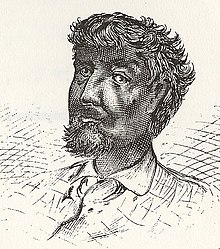
Back جان بابتيست بوينت دو سابل Arabic جان بابتيست بوينت دو سابل ARZ Jean Baptiste Point du Sable Czech Jean Baptiste Point du Sable German Jean Baptiste Point DuSable Spanish ژان بپتیست پوینت دو سابل Persian Jean Baptiste Pointe du Sable French Jean Baptiste Pointe du Sable HT Jean-Baptiste Pointe du Sable Hungarian Jean Baptiste Point du Sable ID
Jean Baptiste Pointe du Sable | |
|---|---|
 | |
| Born | before 1750 |
| Died | August 28, 1818 St. Charles, Missouri Territory, U.S. |
| Nationality | unknown; traditionally stated to be Haitian (Saint-Dominguen), from the French colony of Saint-Domingue |
| Other names | Point de Sable, Point au Sable, Point Sable, Pointe DuSable |
| Occupation | Trader |
| Known for | Founder of Chicago |
| Spouse(s) | Kitihawa (also known as, Catherine) |
| Children | 2 |
Jean Baptiste Point du Sable (also spelled Point de Sable, Point au Sable, Point Sable, Pointe DuSable, or Pointe du Sable[n 1]; before 1750[n 2] – August 28, 1818) is regarded as the first permanent non-native settler of what would later become Chicago, Illinois. Recognized as the city's founder,[7] the site where he settled near the mouth of the Chicago River around the 1780s is memorialized as a National Historic Landmark, now located in Pioneer Court.
Point du Sable was of African descent, but little else is known of his early life prior to the 1770s. During his career, the areas where he settled and traded around the Great Lakes and in the Illinois Country changed hands several times between France, Britain, Spain and the United States. Described as handsome and well educated, Point du Sable married a Potawatomi Native American woman, Kitihawa, and they had two children. In 1779, during the American Revolutionary War, he was arrested by the British on suspicion of being an American Patriot sympathizer. In the early 1780s he worked for the British lieutenant-governor of Michilimackinac on an estate at what is now St. Clair, Michigan.
Point du Sable is first recorded as living at the mouth of the Chicago River in a trader's journal of early 1790. By then he had established an extensive and prosperous trading settlement in what later became the City of Chicago. He sold his Chicago River property in 1800 and moved to the port of St. Charles, where he was licensed to run a ferry across the Missouri River. Point du Sable's successful role in developing the Chicago River settlement was little recognized until the mid-20th century.
In 20th and 21st century Chicago, a school, museum, harbor, park, bridge, and road have been named in du Sable's honor.
- ^ Davey, Monica (24 June 2003). "Tribute to Chicago Icon and Enigma". New York Times. Retrieved 25 August 2010.
- ^ Andreas, Alfred Theodore (1884). History of Chicago. From the earliest period to the present time, volume 1. A. T. Andreas. Front matter. Retrieved 25 January 2011.
- ^ Junger, Robert (2010). Becoming the Second City: Chicago's Mass News Media, 1833–1898. University of Illinois Press. p. 3. ISBN 978-0252077852.
- ^ Cite error: The named reference
Swensonwas invoked but never defined (see the help page). - ^ Ganz, Cheryl R. (2012). The 1933 Chicago World's Fair: A Century of Progress. University of Illinois Press. p. 184. ISBN 978-0252078521.
- ^ Quaife 1933, pp. 42–43
- ^ Cite error: The named reference
Baumann59was invoked but never defined (see the help page).
Cite error: There are <ref group=n> tags on this page, but the references will not show without a {{reflist|group=n}} template (see the help page).
© MMXXIII Rich X Search. We shall prevail. All rights reserved. Rich X Search